Naturalist’s Notebook: August 02 – August 08.
It occurs to me from time to time, while I am whalewatching, that what we experience, whether it is the whales or fish or sharks or birds or seals, is all taking place at or near the surface of the sea. And that what is going on beneath the surface still remains quite a mystery. When I first came here to whalewatch, one of my collegues pointed out to me that we know more about the surface of the moon than we do about the depths of the ocean. And that there are far more species that live in those depths than above the surface. It is with that in mind that, every Saturday, I pull the minnow trap from the Dolphin VII’s float. Over the last several years, I have found some very interesting things in that minnow trap, ranging from pipefish and tiny flounders to seastars and snails. The occasional mud crab and spider crab have been found. But almost every week, there are Green Crabs. And, on Saturday morning, when I bring the green crabs out and explain to the passengers, especially the youngsters, their role in the environment (or, at least, so far as I understand it), it is quite rewarding to me as an educator to see the looks on their faces. You see, green crabs feed on dead matter, detritus, that they find on the bottom. That makes them an essential cog in the machinery of life. I talk about the food web frequently when explaining why Stellwagen is a very productive place to find whales. And I try to do so simply. The phytoplankton use nutrients in the water and the energy of the sun, in the presence of chlorophyll, to make food for themselves (the primary producers). They are then fed upon by a myriad of tiny animals that cannot swim against the current (zooplankton). They are, in turn, fed upon by larger and larger and larger animals. But, at some point, the animals are so very large that very little is eating them. The energy cycle doesn’t end there. Eventually, these animals die and sink to the bottom, creating a huge wealth of proteins and carbohydrates. It is then that comparatively small animals feast on them. Green crabs are one such small animal.
Like all crabs, they have external skeletons (hard shells) that house their muscles rather than interior bones that their muscles wrap around. That is usually the first thing that young passengers notice. They usually then notice two pincers and eight legs (a total of ten). So we talk first about the way the crab moves more from side to side rather than front to back. And then about the use of pincers as defensive weapons and as tools for feeding. The small and slender build of the claws shows they are far more important to feeding than to defense, being used to rip pieces from dead things and bring them to the mouth of the crab. A mouth that opens from side to side rather than up and down. Then somebody will notice the eyestalks and how useful they would be to an animal that is trying to conceal itself at the bottom and still wants to be able to look all around it. And the antennae. Usually, by now, one of the youngsters has turned it over and noticed the way it appears that a tail might have fused with the abdomen. I am often amazed at just how much young whalewatchers make note of.
August 02, 03, and 04 were filled with sightings of mother and calf pairs; including Hancock, Cajun, Manhattan, Firefly, Jabiru, Cardhu, Pepper, Rapier, and Freckles, all with their 2015 calves.
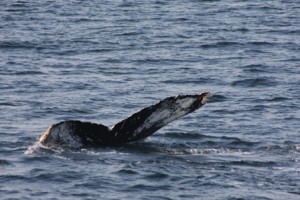
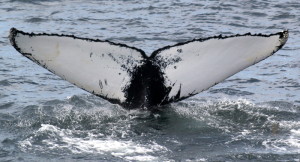
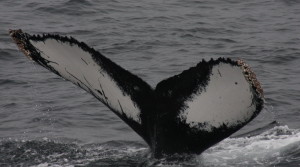
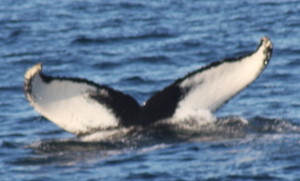
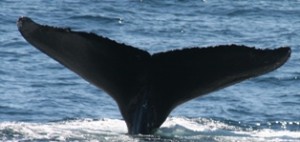
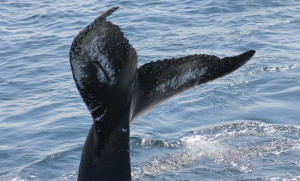
These calves would have been born over the past winter in the warmer waters, likely off the coast of the Dominican Republic or Puerto Rico. At birth, humpback whales are tiny compared to what they will be as adults. Ten to twelve feet long and weighing in at about three-quarters of a ton, at birth,these animals may grow to be forty or forty-five feet long and upwards of fifty tons when full grown. In their first year alone, a humpback whale calf will nearly double its body size, adding about a hundred pounds a day to its weight while it nurses on very thick, rich milk. In that time, too, it will add about a foot to its length every month.
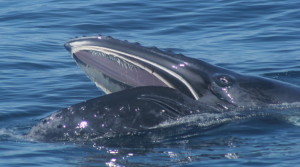
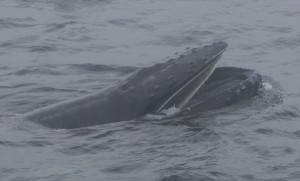
These days were also filled with reports of breaching and lobtailling and flippering. In many of the reports, it was a calf that was active at the surface. The calves do appear to breach and flipperslap, etc, more frequently than adults. Nancy reports on the 4th though that it was both Pepper and her calf that repeatedly breached. Therese reports a solid twenty minutes of a mother and her calf breaching on the 2nd. Sometimes they breach only once and sometimes they can go on for an hour or so. It probably depends on why they are breaching (lobtailling, flippering, etc). Surface active behaviors are thought to be ways they communicate with each other, and other things in their surroundings. In this role, the behaviors are probably like the word “aloha.” They probably have numerous meanings depending upon the context. They are also thought to be used as a way to groom the surface of the whale’s body, knocking dead skin and parasites off. And, of course, with calves and juveniles, play and exercise are another posibility. At one point, Mark said, “In the afternoon, we worked on the SWC [Southwest Corner] with 14 [humpbacks], in groups of 2 to 4 with whales full spinning head breaching, tail[breaching], flip slapping, lobtailing. Everything BUT feeding.” On the 4th, Ellie reported seeing two adults flippering beside each other. And, on the same day, Emily reported three flipperslapping at once.
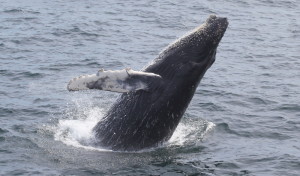
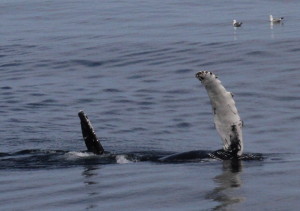
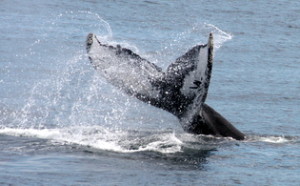
Reports from the end of the week mirrored those from the beginning, with the addition of probable subsurface feeding occuring nearly every day. There were also a few scattered reports of kick feeding and other surface feeding behaviors. From the 5th, Carolyn reports kick feeding in the morning and Dennis reports minkes and humpbacks lunging beneath piles of gulls and shearwaters. And, as if that wasn’t enough, August 5 was capped off by a spectacular sunset that set Provincetown aglow in pinks while setting the western sky ablaze with reds.
And on August 7, there was a rare report of a single common dolphin.
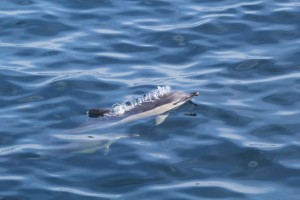
One last really noteworthy experience for the passengers this week was the curious approach that thrilled whalewatchers of the Dolphin VIII on August 8. Bayou, and a whale that has yet to be identified, spent more than twenty minutes passing back and forth beneath the boat, coming to the surface in spyhops. For this encounter, there was not a bad place on the boat to be standing. Bayou and the second whale actually did come to the surface at almost every clockpoint around the boat. At one point, a third whale joined in the curious encounter, but just for a moment before moving on.





